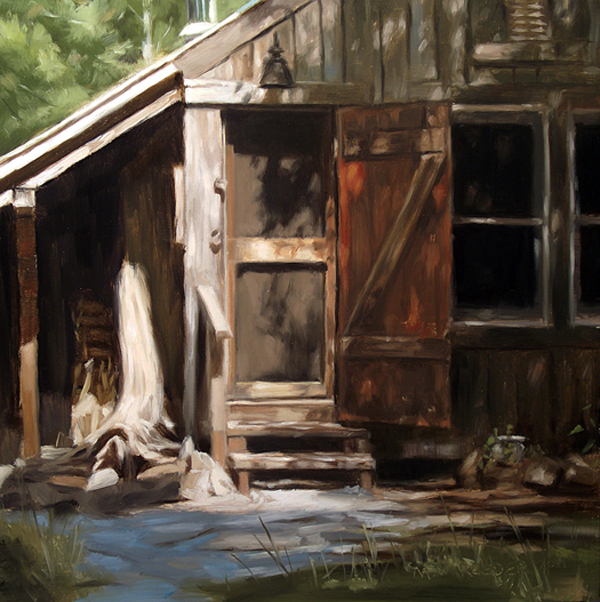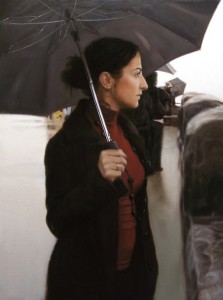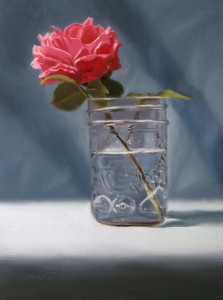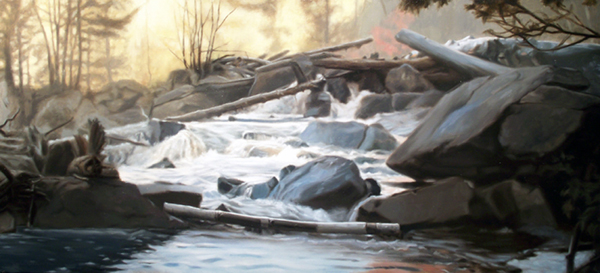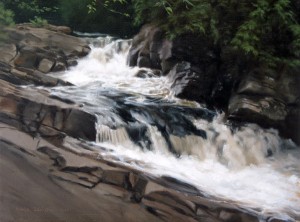Portrait of an Artist: Interview with Mark Reeder
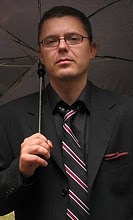 How would you describe your painting style?
How would you describe your painting style?
I would describe my painting style as having a strong foundation in Realism. My aim is to capture as faithfully as possible the subjects I choose to paint as I see them in nature. In my work, I seek to balance the freshness of the brushstroke with the sense of reality that comes from a dedication to traditional painting techniques and a reverence for nature.
Who have been the principal influences over your style?
When I was a young boy I was greatly inspired by the artists of the Renaissance, namely Leonardo Da Vinci, but as I grew older I found my tastes leaned more to the Baroque Era. Caravaggio, Rembrandt, and Vermeer were enormous inspirations for me and I studied their work in great depth trying to understand their method and how they achieved such magnificent works. I also found that the mood of paintings from this period felt very familiar to me and always left me with a sense of awe. Currently I feel more drawn to works from the 19th century. I love the exploration of daylight, humility, beauty and nature.
What do you look for in selecting a subject or scene?
I find instinct plays a very important role but shares in the decision making with logic and reason. Paying attention to such things as structure and form, geometry, the balance of shapes and looking for focal points are very important to me. Art for me is a balance of sound principles with creative inspiration. I look to make many of my choices on purpose to promote specific qualities rather than letting something else take the wheel, however, there is also something to be said about letting the painting paint itself.
What is it you think that your work is meant to convey?
Through my work, I seek to promote very specific qualities. My intention is to paint images that can be described as clean, clear, and created with care. I have never followed the philosophy of creativity at all costs. I much prefer to choose my subjects and the style in which I paint purposefully to reflect and generate the kind of life I wish to build. Almost like a personal journal, but at the same time seeking to connect with universal truths or nature. I wouldn’t say that my work is overtly philosophical, but my intentions behind the work and reasons for my choices are. I look to create works that are humble, clean, and embody something I wish to see in the world.
In addition to being a landscape painter, you’re also known as a portrait artist; what are the fundamental differences or similarities between your portraits and landscape paintings?
For many years I considered myself as a portrait artist first. I’ve been in love with portraits since the beginning; however, landscapes are quickly demanding more and more of my attention. The pull to be outdoors, painting en plein air or using studies done on location and working in the studio have become a compulsion for me lately. It doesn’t really surprise me since part of the reason why I moved to Muskoka was to paint more landscapes. I just didn’t realize how powerful the inspiration would be. At the time I was still looking to find out what kind of landscapes I wanted to paint and now I’m finding that I can’t paint them enough. I love the fresh air, hiking in and around Algonquin Park and the challenge of finishing a painting on location. Painting outdoors is truly a magical experience. There are many magical aspects to painting portraits as well, but fundamentally I think one appeals to my academic mind and the other sets me free.
I understand you live just outside Algonquin Park; can you explain your relations to the Park both as a painter and as a person?`
I moved up here from Toronto a few years ago to really delve into landscape painting. Especially painting en plein air. Up to that point, I was more known for my portraits and still life paintings and I wanted to explore my interest in landscapes. I felt that landscapes were the next subject that I was deeply inspired to paint. Where I live now was once my grandparents house and I work out of the art gallery and studio that belonged to my grandfather. My grandfather’s name was William Kratzer and he was a landscape painter here for more than 30 years. He was a great man and showed me many things. One of the most important things he passed on to me was that you can make a living as an artist and that it is a viable occupation. All artists at some point are faced with this idea or pressure that being an artist is just a hobby or not a real job and it was extremely difficult for me to press through that. I am extremely thankful for his example and all of his encouragement. I’ve been coming up here for as long as I can remember. My grandfather and I would go out into Algonquin Park on hikes every chance we could, so this whole area feels very much like home.
You’ve done quite a few paintings in Algonquin Park; what connection do you think artists share with this Park?
I’ve always found Algonquin Park to be somewhat of a quiet beauty. The lakes, trails and lookouts all seem to be in a state of humble meditation. Every time I go into the park it always feels like a Zen experience. Even in stormy weather or when looking out into the seemingly endless expansive view from a lookout trail, it always seems soothing to me. I feel a similar sense when I look at other works from contemporary artists as well from celebrated painters of the past. It would be an interesting topic of conversation after a day of painting with a group of fellow artists.
How has landscape painting in Canada changed, in your opinion, since Tom Thomson and the Group of Seven?
When I was younger the members the Group of Seven were the only landscape painters that were really held up in high esteem, at least in school. Although I did like their work, I always felt they were promoted far too often, neglecting many other great landscape painters, especially in Canada. I would have to attribute much of my perception or the attitude that I had then to the ignorance of my youth. It did serve me well at the time though as I rebelliously searched out the great Masters of the past; trying to find the kind of voice I would create for myself, searching for the artist I wanted to be and to see what I could bring to the table. Now I find the older I get, the more I respect what the Group of Seven accomplished. As much as Realism is coming back into favour in the art world, so is plein air work. I see them both as probably the strongest movements in the art world today. On all my plein air adventures, I have the luxury of a car to get me most of the way. Painters like members of the Group of Seven were true pioneers, venturing out into the bush in all kinds of weather in all seasons and coming out with new, fresh work as if it were all in a days work. They really inspire me, as do many other artists working en plein air today and they push me to work harder and better everyday.
What was your most memorable experience in the Park?
My most memorable experience would be all the times my grandfather and I would go The Lookout Trail. We would try to get there every summer. The memories of sharing it with him, as well as feeling the wind coming over the landscape gazing out from the lookout was very special. It might not be a memory about painting but it filled me with awe, wonder and humility, and certainly inspired my love for nature. A love that would eventually inspire me to share my connection with some of Canada’s wilderness through my love of painting.

